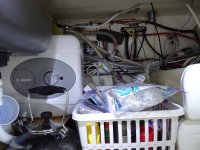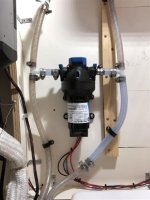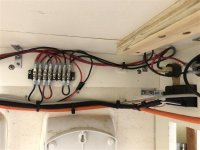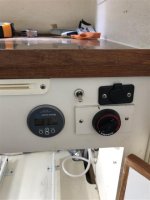smckean (Tosca)
New member
I have a hot water heater on my CD25. I never use it. I am at anchor 85% of the time so no shore power and water is precious. Indeed, it is that last value, conserving water, that is the primary reason I don't use the heater since one has to run over a quart of water into the sink (or saving container) before the hot water can make the long trip from the heater to the galley faucet. The power issue can be solved with my Honda 2000i generator; but how to not waste water? I've thought of ways around this, but my ideas were always too cumbersome to actually bother to implement. Then talking to a contractor last night about circulating hot water systems in houses, a simple solution dawned on me. Question is....will it work? So I thought I'd ask this august body for opinions.
The idea is to install a small switched pump under the galley sink that interconnects the hot and cold water lines just before the galley sink. When you want hot water, you turn on the switch and the pump takes hot water from its line and pumps it into the cold water line -- this should result in water circulating round and round thru the hot water heater (note the main fresh water pump would not be on at this time). One will have learned to count the seconds it takes for hot water to reach the faucet (say 10 seconds), so you count off those seconds and turn off the circulating pump. Now you have hot water right at the hot water tap.
Now, thinking thru what other consequences there are....I don't think cold water will find a path thru the recir pump since pumps have check valves to stop reverse flow. There may be some leakage thru the recir pump from the hot water line to the cold if you are running hot water, but so what. The recir pump is not running so there can't be very much water flowing thru the recir pump considering the main water pressure pump will now be on; so the pressure in both the hot and cold lines will be nearly the same. And even if a little hot water does leak thru the stopped recir pump, it wouldn't hurt much since you are using hot water anyway.
What do the experts think? Where's the flaw in my logic?
The idea is to install a small switched pump under the galley sink that interconnects the hot and cold water lines just before the galley sink. When you want hot water, you turn on the switch and the pump takes hot water from its line and pumps it into the cold water line -- this should result in water circulating round and round thru the hot water heater (note the main fresh water pump would not be on at this time). One will have learned to count the seconds it takes for hot water to reach the faucet (say 10 seconds), so you count off those seconds and turn off the circulating pump. Now you have hot water right at the hot water tap.
Now, thinking thru what other consequences there are....I don't think cold water will find a path thru the recir pump since pumps have check valves to stop reverse flow. There may be some leakage thru the recir pump from the hot water line to the cold if you are running hot water, but so what. The recir pump is not running so there can't be very much water flowing thru the recir pump considering the main water pressure pump will now be on; so the pressure in both the hot and cold lines will be nearly the same. And even if a little hot water does leak thru the stopped recir pump, it wouldn't hurt much since you are using hot water anyway.
What do the experts think? Where's the flaw in my logic?





